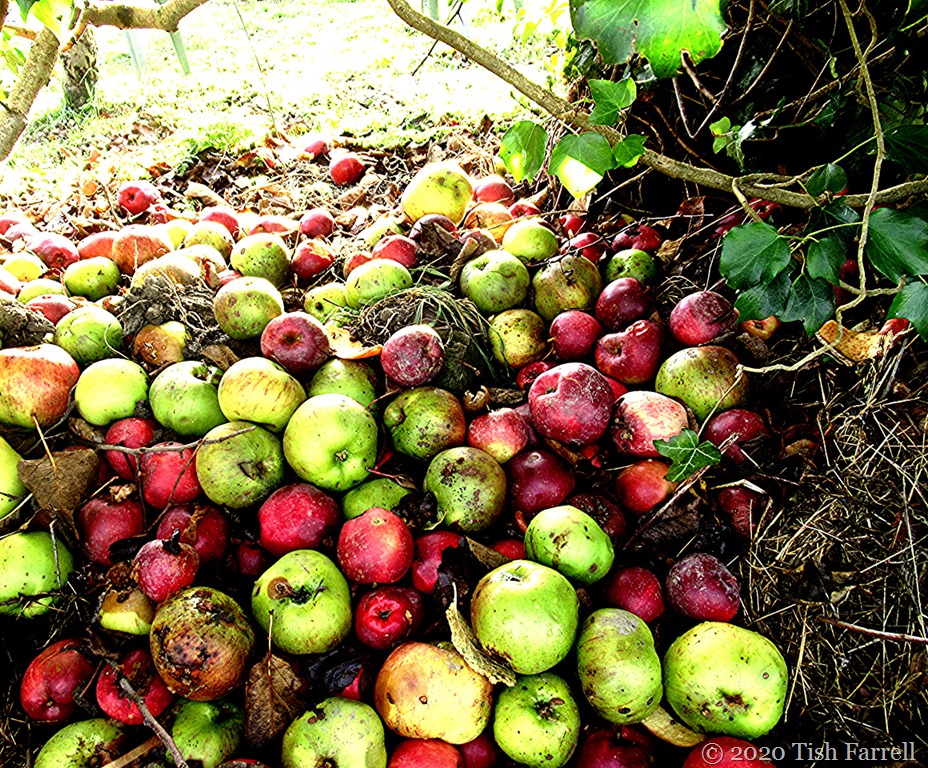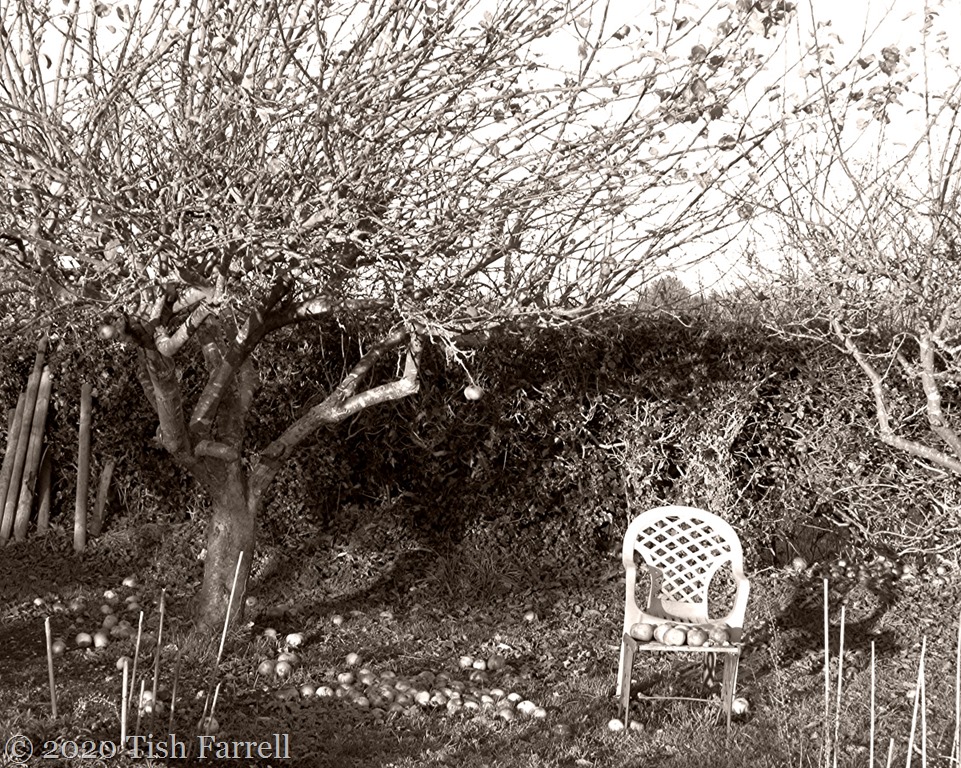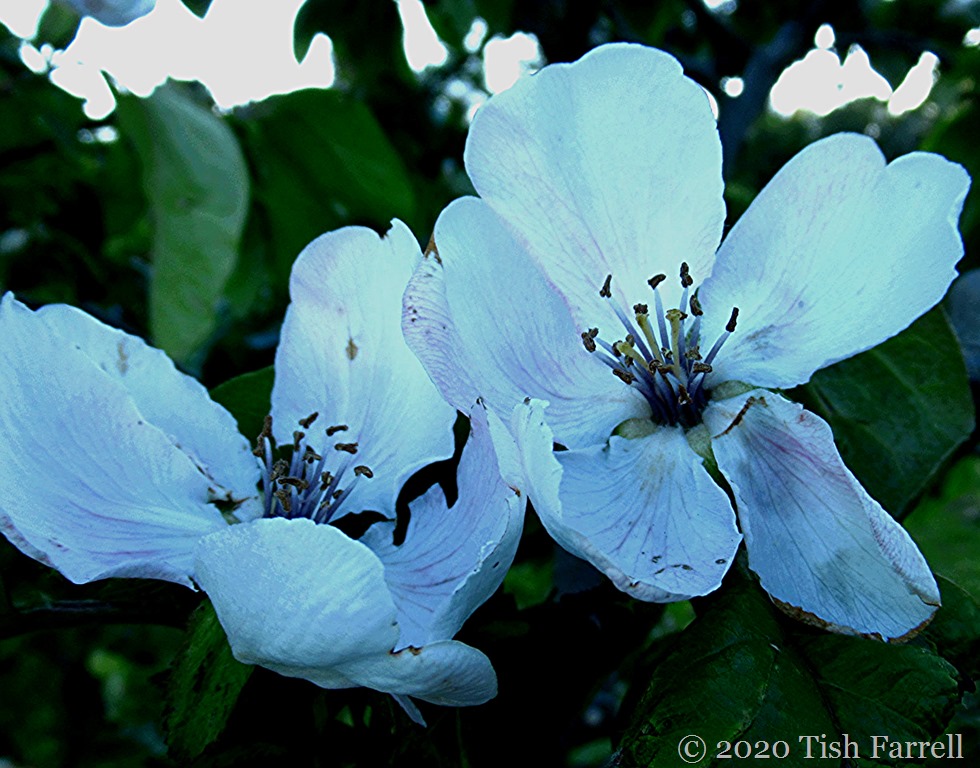My allotment chum Phoebe had pushed this pile of windfalls under the field hedge so the wildlife could tuck in and be sheltered. I spotted them other day, spilling through the undergrowth into the field, and instantly thought of the Andrew Wyeth water colour ‘Frosted Apples’. I didn’t have a camera with me that day, and anyway the light was poor, but I caught them instead a couple of days ago, the afternoon sunshine tumbling after them.
gardening
Windfalls
I took these photos on Sunday afternoon in a fit of late-day sunshine. These are the allotment apple trees, their produce free for anyone to pick. The only problem this year was the crops were so plentiful, and the October winds so fierce, that most of the apples were blown off their stems and into bruising piles. And then there are only so many apple crumbles and pies you can eat if you do not wish to expand to fill one’s particular lockdown premises and so be inextricable by the time we, along with our personal resident viral-bacterial populations, are liberated to the wide world. In the meantime the wildlife of the creeping, pecking sort has a plentiful store to graze on, which in turn serves as a timely reminder that there usually is a positive side to most situations; someone benefits.
Passing thought: the chair in real life is a weathered sage green plastic effort, one of a pair that sat outside my polytunnel for years before I donated them to the communal apple-tree-tea-break-zone. It’s strange it looks so white and also unfocused in these photos; something oddly reflective going on here.
Hands Up! Who Knows What This Flower Is?
A Novel Perspective?
Well it is rather spectacular, isn’t it – for a potato. The variety is Blue Danube and the spuds when I dig them up will be a deep purply-mauvy colour. I’ve not grown them for a few years, but I seem to remember the skins are quite robust (hopefully resistant to slugs) and that inside, the flesh is very white and dry and so they are great for roasting. Which also makes me think they will be just right for the Greek treatment: the addition of water, olive oil (3 parts water to 1 part oil), lots of lemon juice, seasoning and oregano to the roasting tin and a good hour’s cooking.
Usually the potatoes are ready to harvest when the flowers have died down. I’m thinking I might not be able to wait that long.
Leading You Up My Garden Path
Our cottage is built into a fieldside bank. The garden is broad (as wide as the house), but not deep. Or rather it is deep since it drops off about 8 feet to the right of the frame. The two old privies back onto Townsend Meadow. There’s a very free-form hedge of many plant species behind the foreground flower bed, and a fenced portion (guerrilla garden on the field side) beyond the privies. The deep red smoke bush behind the brolly marks the boundary with next door, and I’m standing with my back against the bespoke, self-built Graham-Shed to take the photo. Here then is the Farrell domain – small and irregularly formed. An upstairs-downstairs-between-floors-short-on-planning sort of a garden.
Square Perspective #18 A seafood teaser from Becky today.
Six Word Saturday And a fabulous Vatican shot from Debbie.
Deconstructed Artichokes And How I Tackle Them
This year we’ve had masses of globe artichokes. I have several different varieties growing at the allotment, probably with the notion (as suggested by gardener-cook Sarah Raven) that doing this would extend the cropping season. It hasn’t. Well, not by much.
My usual way of cooking artichokes (one each) is to split then down the middle, cutting from stem to tip, scoop out the choke, drizzle the cut edges with lemon juice to stop discolouration (optional), then steam the halves for around 20 minutes. While that’s happening I put a dish on the hob and melt a big nugget of butter with a couple of cloves of crushed garlic (sometimes butter and olive oil), and when the artichokes are done, spoon this ‘sauce’ into each hollow.
After that it’s all a matter of pulling off the scaly leaves, dipping their bases in the garlic butter pool and sucking. By the time one gets to the flat juicy base, there’s no point in opting for a knife and fork, we’re all too butter fingered and dribbly chinned. Though a slice of wholemeal bread at this point may come in handy for general mopping up.
It is all incredibly messy, the kind of eating that Graham refers to as an ‘all over body experience’ and one that requires a thorough ‘hosing down’ afterwards. You also need to have ready a big dish for the debris. This later goes to ‘feed’ the hot composting bin.
Anyway, there’s only so much hedonistic dining a body can take, and I was just getting to the point of wondering who else at the allotment might like to eat our artichokes when I remembered Francesco da Mosto’s Venice TV series (2004!) It included a scene of women traders preparing buckets of what Francesco referred to as ‘artichoke bottoms’, these to be sold to Venetian cooks who couldn’t be bothered to confront this often challenging vegetable.
Artichoke bottoms! It had to be tried. The only problem, I quickly discovered, is that you need an incredibly sharp knife. Also most of my green globe heads were supporting an insectopolis of aphids, ants and earwigs that required some determined flushing out. After that it was down to the bread knife to get to the bottom of the bottom. At least it got part of the job done, though I regreted my lack of Venetian finesse.
And so the photo. There comes a point when hacking can devolve to peeling (watching out for spiny leaf tips). As I reached the middle of this particular artichoke, and rather strangely, the last leaves clicked open in unison like a mechanical flower, so revealing the hairy choke and also providing this rather good imitation of a water lily.
I did not photograph the bottoms. After all the battling with bugs and wielding the contents of my knife drawer, there was not much to show for eight heads’ worth of artichoke. They are anyway not very pretty and seem to discolour whether or not you put them in acidulated water. But never mind. I braised them gently in olive oil with crushed garlic and fresh chopped oregano, added sliced baby courgettes and garden peas and served them sprinkled with pandano cheese. Delicious and also eaten using appropriate cutlery, so avoiding the dribbling and hosing down elements of my usual method. Some, of course, might think this drawback.
Sticking To The Plot ~ And The Comfort Of Gardeners
Hurrah! We’ve had rain after weeks without a drop, and at last the nightly allotment watering duty is on hold. It’s a big relief. Throughout May and early June I was spending at least an hour each evening pounding the plot paths, a watering can in each hand, making trip after trip to the water tank, this in a bid to keep newly planted beans, beetroot and greens going strong.
And it’s not only that the effort of hand watering is hard work and bothersome. Somehow it’s also an activity fraught with dilemmas. Because you know very well you can never can give plants what they actually need. It’s all too hit and miss. And then once you start, you need to keep on, and so there’s the problem that plants won’t get their roots down and establish themselves strongly, and in fact this year I’ve been trying not to water too much, relying on mulching wherever I can. Also watering in dry weather tends to compact the soil, which can be a problem around lettuce and carrot seedlings. And so yes, there are many moments when you think aren’t there better ways to spend one’s time.
But then the cropping starts, and when you can devour fresh picked artichokes, the leaf ends well doused in hot garlic butter, or tuck into lightly steamed broad beans served with salsa verde made from garden herbs, or gobble sun-warmed strawberries straight from the plant, or munch on a freshly pulled baby carrot, it’s obvious. It is not only worth it; there IS nothing better.
And so I can report that all on the plot is presently going (roughly) to plan. With the advent of rain last week came the planting out of leeks, sweet corn and assorted caulis and cabbages, Cherokee climbing beans, dwarf French beans, courgettes and squashes. Potatoes have been earthed up, and compost bins emptied and replenished with scavenged vegetation. Butter and runner beans that had been planted out earlier but then had to be sheltered from gale force winds have had their protective covers removed and the climbing pea and seedling asparagus beds have been mulched.
So now for some photos:
Climbing peas Lord Leicester and Alderman bringing up the rear; Belle de Fontenay potatoes centre; in the raised beds: seedling clumps of perennial leeks (Russian variety), kohlrabi and cabbage left foreground, and a rather poor showing of parsnips to the right.
*
As pretty as a pea flower? This one is called Champion, another old variety of climbing pea.
*
Verbascum and the butter bean canes. I have quite a few flowering plants dotted about my two plots. They attract pollinators for one thing, but also make up for some of the unsightly bins and pest protection devices. Pot marigolds grow themselves where they please; likewise the Nigella, and now it seems the wild moon daisies are intent on taking over the place. Behind them are the onion beds netted with enviromesh against allium beetle.
The header poppies are not mine though. They have just appeared in a new wild flower plot in the allotment orchard. Fellow allotmenteers, Phoebe, Siegfried and Ian have been working hard for over a year to reclaim this area of neglected fruit trees for everyone to enjoy, this on top of working their own plots. They are an all round horticultural tour de force, and I think myself very lucky that our lockdown regime has allowed allotment going. Over the past weeks I have been able to see them there and so, more or less social-distanced of course, tap into their positive gardening energies. It would be churlish not to pass some of them on.
So here are more views of the poppies and the reclaimed orchard.
Of Sunset Quince Blossom And Haphazard Tree Creation
I almost missed the quince blossom this year, and had to look hard for a few surviving flowers. These were caught two evenings ago in the allotment orchard. I have my own quince tree of course – though scarcely even a treelet as yet. It’s out in the guerrilla garden behind the old privy sheds. Two autumns ago fellow allotmenteer Siegfried gave me several large quinces from the allotment tree. I duly made quince jelly with them and must have saved some of the pips. These I apparently put in a pot of compost and then forgot about them. The pot was outside all winter, buried under another pot. Then last spring when I was tidying up I lifted the top pot and found five tiny plants underneath – ID then unknown. They looked interesting though – i.e. not like weeds, so I kept them. And then I remembered. Quince offspring!
Apart from the one I’ve planted out, I’ve found a good home for another with a chum who says it is thriving, but I still have three small trees in pots. If the mother tree is anything to go by (and it hasn’t been grafted onto dwarf rootstock), then the offspring should not grow too big. Maybe some more guerrilla planting is called for. My treelet is currently ringed by a crowd of columbine heavies, so it’s hard to spot. Anyway, here’s a photo:
And here’s the mother tree:
Randomized gardening can be so rewarding.
Allotment News ~ Late June Edition
Lately, between showers, I’ve been enjoying the company of birds on my allotment plots. First there’s been the pheasant family – Mr and Mrs and a single puff-ball chick. The adults make soft puck-pucking calls to each other as they wander up and down the weedier areas beyond my borders. I suspect they may also have been nibbling the celeriac seedlings which I’m not so pleased about. More recently I’ve been pursued by robins and hungry blackbirds. They have been most excited by my turning of several compost heaps. One blackbird in particular is adept at filling her beak, five worms at a go, dangling down like a mouth full of ribbons. The robins just nag, moving in at ever closer quarters, and piping up whenever I look like flagging on the heap turning front.
And talking of heap turning, in my last update on plot doings I was feeling a bit despondent over plans to adopt no-dig gardening methods. I realised I would need a phenomenal amount of compost. I think I’m talking tonnes here. (The main principle of no-dig being that you cover all the growing areas with several inches of compost every autumn so you don’t need to dig in spring and thereby upset the balance of soil micro-organisms which create fertility. It also cuts down on weeding and watering). Anyway, I can now report some success, at least in a small way.
Back in March I was inspired by TV gardener Monty Don to try growing new potatoes in a raised bed. I had one ready, with its autumn compost topcoat well applied, so I thought, why not? In went my twelve Pentland Javelin earlies, set out in a grid formation. I simply popped them into the compost layers, placing them around 40 cms/15 inches apart. I then buried the lot in several inches of compost, and covered the bed with horticultural fleece. Later, once they’d started sprouting, I earthed them up with more compost (which accounts for why I found myself short of the stuff later). A fortnight ago, once flowering was over, I pulled up the first plant to see what was going on. And here’s the result (cue fanfare):
*
And coming up next is the raised bed where the rest of the plants are still going strong. I used 2 plastic raised beds (2 x 1 metres) bought from a departing neighbour a couple of seasons ago, each a hand’s span tall, and placed one on top of the other to create enough depth to contain the earthing up compost. The end result of this is: no weeds and no need for digging up. When it comes to harvesting I simply pull up the plants and have a quick scrabble around in the compost like a lucky dip. Also, I’d fully expected slug damage after all the wet weather, but so far there’s none to be seen. In fact these are the best first early spuds I’ve ever grown – in looks, taste, ease of extraction and quantity per plant. And, I repeat: no weeds!
Once the spuds are lifted, I’m planning to use the empty bed for winter sprouting broccoli and kale.
And so, with all this vegetable encouragement, and a break in the rainy season, it’s back to the compost bins and bays and my demanding avian companions. More waste gathering and turning are definitely required. I’m thinking now that no-dig can work, even on my claggy Silurian soil – albeit one raised bed at time and with mega quantities of compost. In the meantime, here’s Mrs Pheasant, a view of a scarcely visible chick, and a bee in the nigella:
Blooming Small Things Up At The Allotment
Look Out! The Wood’s On Fire
For one reason and several it was nearly 6 pm by the time I headed to the allotment yesterday. It had been a perfect day, an almost summer day, and I was sorry I’d not gone gardening sooner. There were, after all, the first early spuds and onion sets to plant, and parsnips and peas to sow, and several other jobs to be done. When I did finally get myself there, the sunset was so brilliant, I took to snapping scenes like this instead of doing what I’d meant to do. The rooks watched me from their gathering points on the powerlines, and even let me take their photo. Otherwise, I had the allotment entirely to myself, and there was that deep sense of the plots settling down for the night, free of their gardeners’ interventions.
I did make it to the polytunnel eventually. And in the remaining half-light planted out some lettuce seedlings in one of the raised beds. Then sowed some Early Onward peas in pots, since sowing them in the ground only seems to feed the mice. I also decided it was time the sprouted Aqua Dulce broad beans, likewise sown in mouse-avoiding trays, should go outside on the potting bench under some fleece before they grew to used to the warmth in the tunnel. And I had just stepped out of the polytunnel to fill my watering cans, when I saw this:
A moon in the pink, and the rooks flying over it. And I thought it probably was time to go home. And so a few photos later, I set off across the darkening plots, scrambled through the gap in field hedge into Townsend Meadow, again beheld the moon in picture book mode, this time over the Priory ruins, and thought how good it was to be alive, and that this was my first ‘home from the plot by moonlight’ of 2019.
copyright 2019 Tish Farrell














































